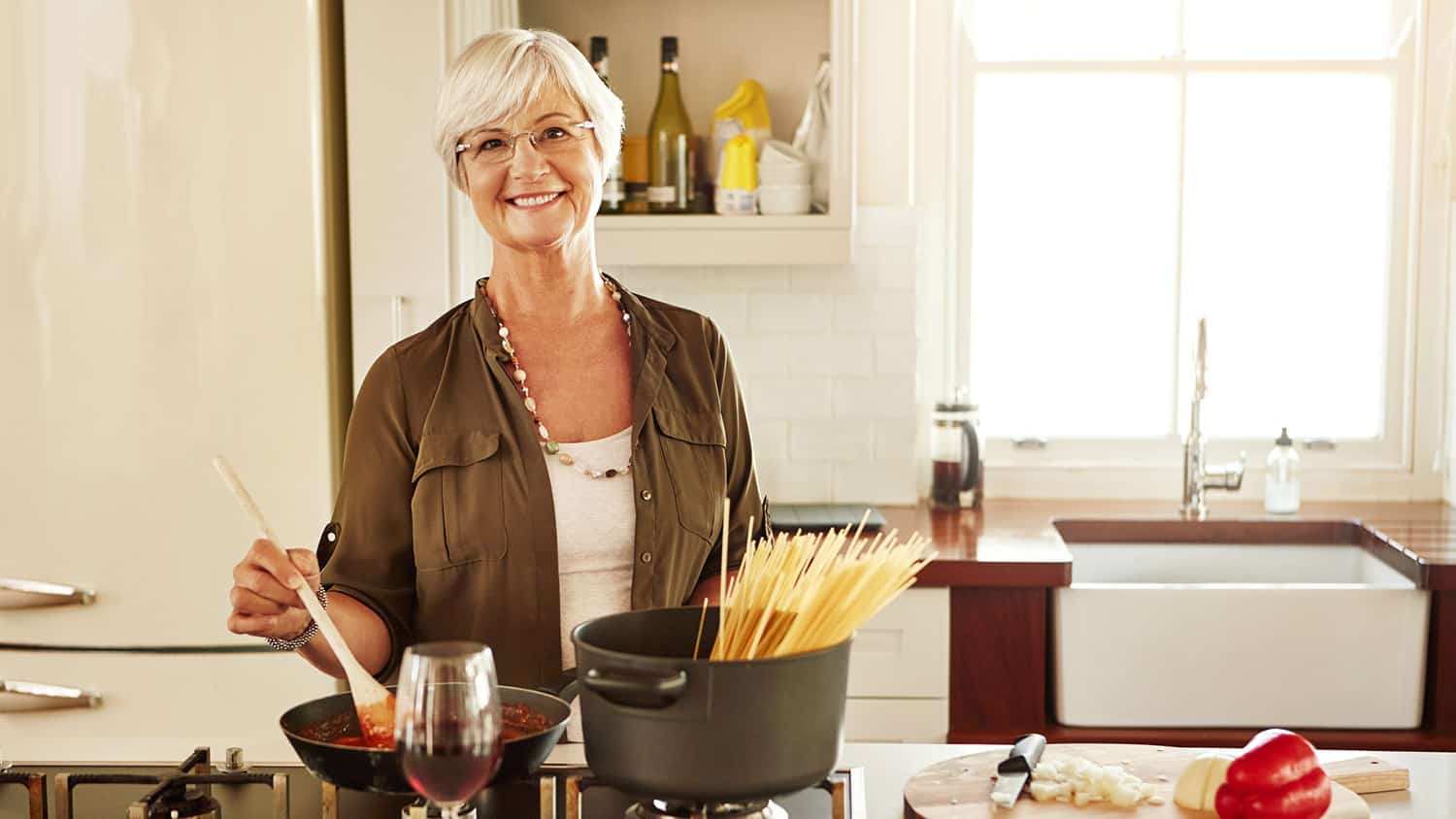
How to Adopt Healthy Eating Habits When You’re Only Cooking for One or Two
Most of us at this stage in life are living in a downsized family. That is, it’s usually just us or perhaps us and a spouse or significant other. But have you noticed that many food ingredients, recipes and even baking pans are sized for many more diners? This can make adopting healthy eating habits difficult.
Healthy Eating Habits Begin at Home
Of course, the first rule of thumb for healthy eating is that you need to prepare as many of the meals you eat as possible from scratch, at home. When you go out to eat at a restaurant, café or fast food joint – or even browse the aisles of processed and packaged food at your local market – you simply can’t control what ingredients are used. I’m talking about chemicals, preservatives, dyes, sugar and more.
Consider this: even though a prepared salad may seem like a healthy choice, odds are good that the dressing contains sugar, the ingredients are overly fatty or salty and often meat (chicken, bacon, or fish) is deep-fried. So while a salad may seem at first glance to be the good choice, you have to carefully examine the ingredients.
The better choice? Buying each ingredient at the market and assembling a salad yourself, then topping with a homemade dressing of oil and vinegar kicked up with some spices, chopped herbs or whole-grain mustard.
Shopping for One or Two
I know, I know – it’s hard to buy vegetables and fruits in small enough quantities to ensure none of it goes to waste. No one wants to eat the same thing over and over again, for days at a time, until all the ingredients you purchased are cleaned from the fridge. And when it comes to some delicate produce, it must be eaten in a couple days for optimal freshness.
Of course, it’s best to buy the smallest quantities available. Often, that means paying a bit more. For instance, at my local grocery store, they promote packages of pre-cut produce, such as pineapple chunks, watermelon slices, asparagus with the ends snapped off, cauliflower and broccoli florets and carrot chips.
If you compare the price, ounce per ounce, to the whole fruit or vegetable, it’s more expensive. But take into account the fact that you can purchase smaller quantities and none of it goes to waste and it’s really not a bad deal at all.
If you are craving a bit of whole grain bread, try heading to your market’s bakery section. Look for a whole grain roll or two rather than buying a whole loaf. Whole grain tortillas, typically sold in packages of a dozen or fewer and shelf-stable for weeks, are another good option to satisfy your craving without waste.
For the freshest salads, opt for packaged greens, which are typically smaller than an entire head of lettuce. The same is true of spinach, chard, kale and other greens.
When possible, choose fresh ingredients that last the longest. In the produce department, that’s potatoes, yams, onions, garlic, cruciferous vegetables (cauliflower, Brussels sprouts) and squash. Nuts keep well under refrigeration and even eggs can last for weeks.
Preserve, Don’t Waste
Before you think about tossing that last little bit of food that you can’t imagine using before it goes bad, consider if it could be repurposed or preserved.
For instance, lots of different foods can be frozen, including grapes, pineapple, bananas (peel them first), cheese, milk, bread, tortillas, cooked vegetables (squash, green beans, carrots and more), prepared salsa and other sauces (tomato, cashew, etc.).
Some foods can be air- or oven-dried, such as herbs or bread cubes. A dehydrator is a great tool to keep around as it will instantly transform slices of apple, pineapple and other fruits into dried treats that will last a long time without refrigeration. Jerky is another snack that is healthy when you dehydrate it at home and it’s a great way to use meat before it goes bad.
Make a stock out of leftover bits of onion, garlic bulbs that have gone green, carrots, bell peppers, celery and other fibrous vegetables along with a bay leaf or two. Then, use that stock to make soup with potatoes gone soft and whatever leftovers you can find in the fridge (beans, meat, rice, pasta, etc.). And if you have too much soup to eat for more than a couple days, pour it into containers and freeze.
The same goes for leftover stock – strain it and pour into ice cube trays for perfect recipe-sized bits of cooking liquid.
Prepare Food in Smaller Amounts
And finally, don’t feel compelled to make the same large quantity of food you may have been used to cooking when you had an entire family to feed. Although not all recipes can easily be downsized (Meatloaf? Lasagna? Casseroles?), many of them can be reduced by taking the amount of each ingredient down to a half, third or even a fourth.
Then again, many recipe sites cater to the single diner or couple. On my website, I feature a recipe category called “Recipes for Two” which lists simple, healthy dishes already downsized for a smaller household.
Stick to Your Healthy Eating Habits
No matter how you approach the dilemma of shopping for and preparing meals perfect for one or two people, don’t fall into the trap of buying packaged and processed food at the market – or worse, stopping at a fast food joint. It’s okay to do this every now and then, but if you make it a habit, you will soon find your healthy habits going by the wayside.
How many people do you cook for in your family? What are your favorite recipes and healthy eating habits? Have you found creative ways to use leftover ingredients? Please share in the comments.
Tags Healthy Eating






